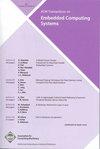GHOST:使用硅光子学的图形神经网络加速器
IF 2.6
3区 计算机科学
Q2 COMPUTER SCIENCE, HARDWARE & ARCHITECTURE
引用次数: 0
摘要
图神经网络(gnn)已经成为一种强大的建模和从图结构数据中学习的方法。从那以后,许多领域都从gnn的能力中受益匪浅,比如推荐系统、社交网络分析、药物发现和机器人技术。然而,加速和有效处理gnn需要一种超越传统人工神经网络加速器的独特方法,因为gnn需要大量的计算和内存需求。CMOS平台的扩展速度放缓也促使人们寻找替代的实现基板。在本文中,我们提出了GHOST,第一个用于gnn的硅光子硬件加速器。GHOST有效地降低了以顶点为中心和以边缘为中心操作的相关成本。它分别实现了在光学域中运行GNN所涉及的三个主要阶段,使其能够用于各种广泛使用的GNN模型和架构的推理,例如图卷积网络和图注意网络。我们的仿真研究表明,与GPU、TPU、CPU和多个最先进的GNN硬件加速器相比,GHOST具有至少10.2倍的吞吐量和3.8倍的能效。本文章由计算机程序翻译,如有差异,请以英文原文为准。
GHOST: A Graph Neural Network Accelerator using Silicon Photonics
Graph neural networks (GNNs) have emerged as a powerful approach for modelling and learning from graph-structured data. Multiple fields have since benefitted enormously from the capabilities of GNNs, such as recommendation systems, social network analysis, drug discovery, and robotics. However, accelerating and efficiently processing GNNs require a unique approach that goes beyond conventional artificial neural network accelerators, due to the substantial computational and memory requirements of GNNs. The slowdown of scaling in CMOS platforms also motivates a search for alternative implementation substrates. In this paper, we present GHOST , the first silicon-photonic hardware accelerator for GNNs. GHOST efficiently alleviates the costs associated with both vertex-centric and edge-centric operations. It implements separately the three main stages involved in running GNNs in the optical domain, allowing it to be used for the inference of various widely used GNN models and architectures, such as graph convolution networks and graph attention networks. Our simulation studies indicate that GHOST exhibits at least 10.2 × better throughput and 3.8 × better energy efficiency when compared to GPU, TPU, CPU and multiple state-of-the-art GNN hardware accelerators.
求助全文
通过发布文献求助,成功后即可免费获取论文全文。
去求助
来源期刊

ACM Transactions on Embedded Computing Systems
工程技术-计算机:软件工程
CiteScore
3.70
自引率
0.00%
发文量
138
审稿时长
6 months
期刊介绍:
The design of embedded computing systems, both the software and hardware, increasingly relies on sophisticated algorithms, analytical models, and methodologies. ACM Transactions on Embedded Computing Systems (TECS) aims to present the leading work relating to the analysis, design, behavior, and experience with embedded computing systems.
 求助内容:
求助内容: 应助结果提醒方式:
应助结果提醒方式:


